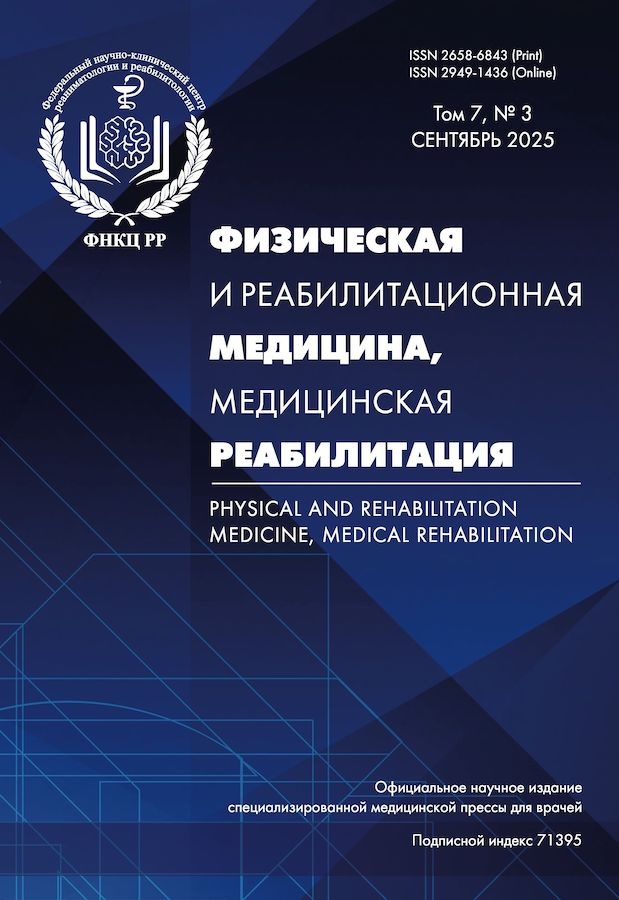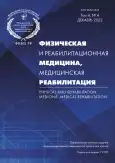Stroke biomarkers: Issues of diagnosis and medical rehabilitation
- Authors: Ponomarev G.V.1, Polyakova A.V.2, Prokhorova M.V.2, Voznjouk I.A.1,3
-
Affiliations:
- I.P. Pavlov First St. Petersburg State Medical University
- Saint Petersburg institute of emergency care n.a. I.I. Dzhanelidze
- Immanuel Kant Baltic Federal University
- Issue: Vol 4, No 4 (2022)
- Pages: 259-270
- Section: REVIEWS
- URL: https://journals.rcsi.science/2658-6843/article/view/232720
- DOI: https://doi.org/10.36425/rehab111899
- ID: 232720
Cite item
Full Text
Abstract
Stroke is the main death and invalidization factor throughout the world. Stroke prevention, early diagnostics and treatment, as well as proper rehabilitation, are the key research directions to reduce death and invalidization numbers.
Current clinical practice widely uses many biochemical markers (biomarkers) found in blood, urine or cerebrospinal fluid to make therapeutic decisions. Used along with standard examination methods, the potential benefit of stroke biomarkers could be seen in stroke type differential diagnostics, complication development forecasting and rehabilitation events personification.
Many potential stroke biomarkers and combined panels, including those used for rehabilitation intensity estimation, are described in science literature. Among them prevail peptide molecules connected with the damage of neurons and their axons, neuroglia, brain vessels endothelium. Less attention is given to blood proteins, lipids and other metabolites. There appears more and more reliable data on circulating nucleic acids as stroke manifestation and progress markers.
Despite obvious clinical and economical biomarkers prospects, no studied stroke markers are used in everyday clinical practice. That could be caused by obtained suboptimal sensitivity and specificity indicators and difficulties with translational studies organization and conducting. Relevance of stroke biomarkers as a way to control rehabilitation intensity also highlights the necessity to additional researches.
Keywords
Full Text
##article.viewOnOriginalSite##About the authors
Grigory V. Ponomarev
I.P. Pavlov First St. Petersburg State Medical University
Author for correspondence.
Email: grigoryponomarev@yandex.ru
ORCID iD: 0000-0002-6219-8855
SPIN-code: 1143-4227
MD, Cand. Sci. (Med.)
Russian Federation, Saint PetersburgAlexandra V. Polyakova
Saint Petersburg institute of emergency care n.a. I.I. Dzhanelidze
Email: polyakova.alexandra@bk.ru
ORCID iD: 0000-0002-6426-3091
SPIN-code: 7714-6154
MD, Cand. Sci. (Med.)
Russian Federation, Saint PetersburgMariia V. Prokhorova
Saint Petersburg institute of emergency care n.a. I.I. Dzhanelidze
Email: airty@mail.ru
ORCID iD: 0000-0003-3412-0038
SPIN-code: 9565-1368
Junior Research Associate
Russian Federation, Saint PetersburgIgor A. Voznjouk
I.P. Pavlov First St. Petersburg State Medical University; Immanuel Kant Baltic Federal University
Email: voznjouk@yandex.ru
ORCID iD: 0000-0002-0340-4110
SPIN-code: 3340-2897
MD, Dr. Sci. (Med.), Professor
Russian Federation, Saint Petersburg; KaliningradReferences
- Feigin VL, Brainin M, Norrving B, et al. World Stroke Organization (WSO): Global Stroke Fact Sheet 2022. Int J Stroke. 2022;17(1):18–29. doi: 10.1177/17474930211065917
- Herpich F, Rincon F. Management of acute ischemic stroke. Crit Care Med. 2020;48(11):1654–1663. doi: 10.1097/CCM.0000000000004597
- Voznyuk IA, Savello VE, Shumakova TA. Emergency clinical neuroradiology. Stroke. Sankt-Peterburg: Foliant; 2016.122 р. (In Russ).
- Piradov MA, Maksimova MY, Tanashyan MM. Stroke: step-by-step instructions. A guide for doctors. 2nd ed. Moscow: GEOTAR-Media; 288 р. (In Russ).
- Kamtchum-Tatuene J, Jickling GC. Blood biomarkers for stroke diagnosis and management. Neuromolecular Med. 2019;21(4): 344–368. doi: 10.1007/s12017-019-08530-0
- Dias A, Silva L, Moura J, et al. Fluid biomarkers in stroke: From animal models to clinical care. Acta Neurol Scand. 2022;146(4): 332–347. doi: 10.1111/ane.13668
- Dagonnier M, Donnan GA, Davis SM, et al. Acute stroke biomarkers: are we there yet? Front Neurol. 2021;12:619721. doi: 10.3389/fneur.2021.619721
- Monbailliu T, Goossens J, Hachimi-Idrissi S. Blood protein biomarkers as diagnostic tool for ischemic stroke: a systematic review. Biomark Med. 2017;11(6):503–512. doi: 10.2217/bmm-2016-0232
- Saenger AK, Christenson RH. Stroke biomarkers: progress and challenges for diagnosis, prognosis, differentiation, and treatment. Clin Chem. 2010;56(1):21–33. doi: 10.1373/clinchem.2009.133801
- Wang W, Li DB, Li RY, et al. Diagnosis of hyperacute and acute ischaemic stroke: the potential utility of exosomal MicroRNA-21-5p and MicroRNA-30a-5p. Cerebrovasc Dis. 2018; 45(5-6):204–212. doi: 10.1159/000488365
- Dewdney B, Trollope A, Moxon J, et al. Circulating MicroRNAs as biomarkers for acute ischemic stroke: a systematic review. J Stroke Cerebrovasc Dis. 2018;27(3):522–530. doi: 10.1016/j.jstrokecerebrovasdis.2017.09.058
- Bejleri J, Jirström E, Donovan P, et al. Diagnostic and prognostic circulating MicroRNA in acute stroke: a systematic and bioinformatic analysis of current evidence. J Stroke. 2021;23(2):162–182. doi: 10.5853/jos.2020.05085
- Foerch C, du Mesnil de Rochemont R, Singer O, et al. S100B as a surrogate marker for successful clot lysis in hyperacute middle cerebral artery occlusion. J Neurol Neurosurg Psychiatry. 2003; 74(3):322–325. doi: 10.1136/jnnp.74.3.322
- Foerch C, Singer OC, Neumann-Haefelin T, et al. Evaluation of serum S100B as a surrogate marker for long-term outcome and infarct volume in acute middle cerebral artery infarction. Arch Neurol. 2005;62(7):1130–1134. doi: 10.1001/archneur.62.7.1130
- Wiese S, Karus M, Faissner A. Astrocytes as a source for extracellular matrix molecules and cytokines. Front Pharmacol. 2012;(3):120. doi: 10.3389/fphar.2012.00120
- Furukawa H, Singh SK, Mancusso R, Gouaux E. Subunit arrangement and function in NMDA receptors. Nature. 2005; 438(7065):185–192. doi: 10.1038/nature04089
- Dambinova SA, Bettermann K, Glynn T, et al. Diagnostic potential of the NMDA receptor peptide assay for acute ischemic stroke. PLoS One. 2012;7(7):e42362. doi: 10.1371/journal.pone.0042362
- Weissman JD, Khunteev GA, Heath R, Dambinova SA. NR2 antibodies: risk assessment of transient ischemic attack (TIA)/stroke in patients with history of isolated and multiple cerebrovascular events. J Neurol Sci. 2011;300(1-2):97–102. doi: 10.1016/j.jns.2010.09.023
- Dolmans LS, Rutten FH, Koenen NC, et al. Candidate biomarkers for the diagnosis of transient ischemic attack: a systematic review. Cerebrovasc Dis. 2019;47(5-6):207–216. doi: 10.1159/000502449
- Stanca DM, Mărginean IC, Soriţău O, et al. GFAP and antibodies against NMDA receptor subunit NR2 as biomarkers for acute cerebrovascular diseases. J Cell Mol Med. 2015;19(9):2253–2261. doi: 10.1111/jcmm.12614
- Allard L, Burkhard PR, Lescuyer P, et al. PARK7 and nucleoside diphosphate kinase A as plasma markers for the early diagnosis of stroke. Clin Chem. 2005;51(11):2043–2051. doi: 10.1373/clinchem.2005.053942
- Tulantched DS, Min Z, Feng WX. Comparison of plasma PARK7 and NDKA diagnostic value in acute stroke. Future Sci OA. 2019;5(5):FSO375. doi: 10.2144/fsoa-2018-0080
- Mingina T, Zhao M. Role of PARK7 and NDKA in stroke management: a review of PARK7 and NDKA as stroke biomarkers. Biomark Med. 2018;12(5):419–425. doi: 10.2217/bmm-2018-0013
- Menon B, Ramalingam K, Conjeevaram J, Munisusmitha K. Role of brain natriuretic peptide as a novel prognostic biomarker in acute ischemic stroke. Ann Indian Acad Neurol. 2016;19(4):462–466. doi: 10.4103/0972-2327.194422
- Maruyama K, Shiga T, Iijima M, et al. Brain natriuretic peptide in acute ischemic stroke. J Stroke Cerebrovasc Dis. 2014;23(5): 967–972. doi: 10.1016/j.jstrokecerebrovasdis.2013.08.003
- Panagopoulou V, Deftereos S, Kossyvakis C, et al. NTproBNP: an important biomarker in cardiac diseases. Curr Top Med Chem. 2013;13(2):82–94. doi: 10.2174/1568026611313020002
- Park KY, Ay I, Avery R, et al. New biomarker for acute ischaemic stroke: plasma glycogen phosphorylase isoenzyme BB. J Neurol Neurosurg Psychiatry. 2018;89(4):404–409. doi: 10.1136/jnnp-2017-316084
- Lim WY, Thevarajah TM, Goh BT, Khor SM. Paper microfluidic device for early diagnosis and prognosis of acute myocardial infarction via quantitative multiplex cardiac biomarker detection. Biosens Bioelectron. 2019;(128):176–185. doi: 10.1016/j.bios.2018.12.049
- Reynolds MA, Kirchick HJ, Dahlen JR, et al. Early biomarkers of stroke. Clin Chem. 2003;49(10):1733–1739. doi: 10.1373/49.10.1733
- Laskowitz DT, Kasner SE, Saver J, et al.; BRAIN Study Group. Clinical usefulness of a biomarker-based diagnostic test for acute stroke: the Biomarker Rapid Assessment in Ischemic Injury (BRAIN) study. Stroke. 2009;40(1):77–85. doi: 10.1161/STROKEAHA.108.516377
- Wu J, Du K, Lu X. Elevated expressions of serum miR-15a, miR-16, and miR-17-5p are associated with acute ischemic stroke. Int J Clin Exp Med. 2015;8(11):21071–21079.
- Tian C, Li Z, Yang Z, et al. Plasma microRNA-16 is a biomarker for diagnosis, stratification, and prognosis of hyperacute cerebral infarction. PLoS One. 2016;11(11):e0166688. doi: 10.1371/journal.pone.0166688
- Pujol-Calderón F, Zetterberg H, Portelius E, et al. Prediction of outcome after endovascular embolectomy in anterior circulation stroke using biomarkers. Transl Stroke Res. 2022;13(1):65–76. doi: 10.1007/s12975-021-00905-5
- Foerch C, Singer O, Neumann-Haefelin T, et al. Utility of serum GFAP in monitoring acute MCA territorial infarction. Cerebrovasc Dis. 2003;16(Suppl. 4):45.
- Foerch C, Curdt I, Yan B, et al. Serum glial fibrillary acidic protein as a biomarker for intracerebral haemorrhage in patients with acute stroke. J Neurol Neurosurg Psychiatry. 2006;77(2):181–184. doi: 10.1136/jnnp.2005.074823
- Dvorak F, Haberer I, Sitzer M, Foerch C. Characterisation of the diagnostic window of serum glial fibrillary acidic protein for the differentiation of intracerebral haemorrhage and ischaemic stroke. Cerebrovasc Dis. 2009;27(1):37–41. doi: 10.1159/000172632
- Katsanos AH, Makris K, Stefani D, et al. Plasma glial fibrillary acidic protein in the differential diagnosis of intracerebral hemorrhage. Stroke. 2017;48(9):2586–2588. doi: 10.1161/STROKEAHA.117.018409
- Mattila OS, Ashton NJ, Blennow K, et al. Ultra-Early differential diagnosis of acute cerebral ischemia and hemorrhagic stroke by measuring the prehospital release rate of GFAP. Clin Chem. 2021;67(10):1361–1372. doi: 10.1093/clinchem/hvab128
- Pelinka LE, Kroepfl A, Schmidhammer R, et al. Glial fibrillary acidic protein in serum after traumatic brain injury and multiple trauma. J Trauma. 2004;57(5):1006–1012. doi: 10.1097/01.ta.0000108998.48026.c3
- Jung CS, Foerch C, Schänzer A, et al. Serum GFAP is a diagnostic marker for glioblastoma multiforme. Brain. 2007;130(Pt 12): 3336–3341. doi: 10.1093/brain/awm263
- Luger S, Jæger HS, Dixon J, et al. Diagnostic accuracy of glial fibrillary acidic protein and ubiquitin carboxy-terminal hydrolase-l1 serum concentrations for differentiating acute intracerebral hemorrhage from ischemic stroke. Neurocrit Care. 2020;33(1):39–48. doi: 10.1007/s12028-020-00931-5
- Leung LY, Chan CP, Leung YK, et al. Comparison of miR-124-3p and miR-16 for early diagnosis of hemorrhagic and ischemic stroke. Clin Chim Acta. 2014;(433):139–144. doi: 10.1016/j.cca.2014.03.007
- Castellanos M, Leira R, Serena J, et al. Plasma metalloproteinase-9 concentration predicts hemorrhagic transformation in acute ischemic stroke. Stroke. 2003;34(1):40–46.
- Yuan R, Tan S, Wang D, et al. Predictive value of plasma matrix metalloproteinase-9 concentrations for spontaneous haemorrhagic transformation in patients with acute ischaemic stroke: a cohort study in Chinese patients. J Clin Neurosci. 2018;58:108–112. doi: 10.1016/j.jocn.2018.09.014
- Inzitari D, Giusti B, Nencini P, et al. MMP9 variation after thrombolysis is associated with hemorrhagic transformation of lesion and death. Stroke. 2013;44(10):2901–2903. doi: 10.1161/STROKEAHA.113.002274
- Mechtouff L, Bochaton T, Paccalet A, et al. Matrix metalloproteinase-9 relationship with infarct growth and hemorrhagic transformation in the era of thrombectomy. Front Neurol. 2020;(11):473. doi: 10.3389/fneur.2020.00473
- Krishnamoorthy S, Singh G, Jose KJ, et al. Biomarkers in the prediction of hemorrhagic transformation in acute stroke: a systematic review and meta-analysis. Cerebrovasc Dis. 2022;51(2):235–247. doi: 10.1159/000518570
- Tiedt S, Duering M, Barro C, et al. Serum neurofilament light: a biomarker of neuroaxonal injury after ischemic stroke. Neurology. 2018;91(14):e1338–e1347. doi: 10.1212/WNL.0000000000006282
- Purroy F, Farré-Rodriguez J, Mauri-Capdevila G, et al. Basal IL-6 and S100b levels are associated with infarct volume. Acta Neurol Scand. 2021;144(5):517–523. doi: 10.1111/ane.13487
- Uphaus T, Bittner S, Gröschel S, et al. NfL (Neurofilament Light Chain) levels as a predictive marker for long-term outcome after ischemic stroke. Stroke. 2019;50(11):3077–3084. doi: 10.1161/STROKEAHA.119.026410
- Jiang J, Tan C, Zhou W, et al. Plasma C-reactive protein level and outcome of acute ischemic stroke patients treated by intravenous thrombolysis: a systematic review and meta-analysis. Eur Neurol. 2021;84(3):145–150. doi: 10.1159/000514099
- Oh BM. A path to precision medicine: incorporating blood-based biomarkers in stroke rehabilitation. Ann Rehabil Med. 2021;45(5): 341–344. doi: 10.5535/arm.21171
- Zeng L, Liu J, Wang Y, et al. MicroRNA-210 as a novel blood biomarker in acute cerebral ischemia. Front Biosci (Elite Ed). 2011;3(4):1265–1272. doi: 10.2741/e330
- Zhou J, Chen L, Chen B, et al. Increased serum exosomal miR-134 expression in the acute ischemic stroke patients. BMC Neurol. 2018;18(1):198. doi: 10.1186/s12883-018-1196-z
- Picelli A, Filippetti M, Del Piccolo L, et al. Rehabilitation and biomarkers of stroke recovery: study protocol for a randomized controlled trial. Front Neurol. 2021;11:618200. doi: 10.3389/fneur.2020.618200
Supplementary files








